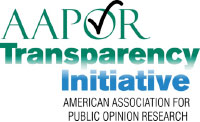AAPOR’s Polling Transparency Initiative Officially Launches
Timothy P. Johnson, Transparency Initiative Coordinating Committee Chair
ASA’s Statement on the Initiative
“The American Statistical Association recognizes the importance of transparency in survey research methods and hence endorses the American Association for Public Opinion Research’s Transparency Initiative. The ASA encourages all professional organizations involved significantly in the collection and/or analysis of survey data to join this important movement.”
The American Association for Public Opinion Research’s (AAPOR) Transparency Initiative formally opened for business October 8, 2014. Since then, more than 40 survey-based organizations have applied and been accepted for membership, and new members continue to be admitted almost weekly.
For many years, AAPOR has advocated for transparency in the public reporting of public opinion and survey research. The growing diversity in approaches to survey sampling and data collection makes the clear disclosure of research methodology essential to ensure that both the public and other researchers have the information necessary to judge the quality of survey research.
AAPOR created the transparency initiative to encourage wider and more effective disclosure of research methods. Its goal is to promote methodological disclosure through a proactive, educational approach that assists survey organizations in developing simple and efficient means for routinely disclosing the research methods associated with their publicly released studies.
As part of AAPOR’s goal of promoting an open science of public opinion and survey research, the transparency initiative now recognizes organizations that pledge to consistently practice transparency in their reporting of survey-based research findings. In doing so, AAPOR makes no judgment about the quality or rigor of the methods being disclosed. But full and effective disclosure improves the ability of consumers to make those judgments.

The disclosure standards for the transparency initiative are the same standards found in the AAPOR Code of Professional Ethics and Practices, which all individual members of AAPOR pledge to follow. But the transparency initiative applies these standards to organizations. AAPOR assists participating organizations in complying with the initiative and seeks to educate survey sponsors and the public about the importance of transparency.
The process for joining the transparency initiative is not difficult. Organizations are asked to designate a liaison and pledge to abide by AAPOR’s disclosure standards, to train their employees to do so, and to document that they understand how to properly disclose the methodology of the public opinion and other surveys they conduct. Organizations that join the transparency initiative before October of 2015 will be designated as charter members.
Participating organizations benefit by receiving formal, public recognition of their voluntary commitment to abide by the disclosure standards of AAPOR’s Code of Professional Ethics and Practices. The profession also benefits by elevating the transparency, and hence the integrity, of its work. The public benefits by having greater access to detailed information with which to evaluate the quality of survey data being reported.
In support of the transparency initiative, the editors of AAPOR’s three journals—Public Opinion Quarterly, Journal of Survey Statistics and Methodology, and Survey Practice—announced earlier this year that they now require the reporting of all transparency initiative disclosure elements as part of each manuscript submitted for peer review. The American Statistical Association, World Association for Public Opinion Research, and Association of Academic Survey Research Associations have all endorsed the initiative.
Read more about the transparency initiative, including access to online educational resources.

















